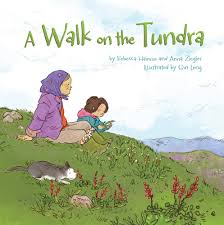What is a story vine?
According to Sometimes Reading is Hard, story vines come from an African tradition that uses visual cues to assist in the oral retelling of a story or legend (p. 91). Story vines are commonly made from braided yarn and will include different toy-like artifacts which are affixed to the braid in chronological order. This can help introduce students to sequencing, new vocabulary, and to develop fluency in reading and talking (Bright, p. 91).
How to use it in your classroom
- Choose a book
Before you have your students create their own story vine, it is important you as the educator make one to reference and show your class. Select a book you love and one that you know well. Try to choose one that is sequentially easy to follow, and has engaging characters and a satisfying ending (Bright, p. 91).

For my book, I chose A Walk on the Tundra by Rebecca Hainu. This is a story about a young girl living in an Inuit village who discovers the wonderful world of edible and medicinal flora when she tags along with her grandmother for a walk on the tundra, and how it is intricately intertwined with their culture and traditional values.
2. Create your vine

For my story vine, I used multiple different colours of yarn that matched those found in the book. For the visual pieces to tell the story, I created small clay figurines and flowers. While story vines do not normally have words on them, I have decided to include certain words from the text as many plants are named in Inuktitut, the language spoken by the Inuit. Language is an integral part of a culture, and I want to honour the authors’.
3. Read your story
Using your story vine, share the story to the class with expression and enthusiasm. While your rendition of the story may not be exactly word-for-word, the students should be able to pick up on key phrases they recognize from the text.
4. Have students make their own story vines
Once students have had the chance to see it in action, have them create their own story vine, either from the same story or one that resonates deeply with them. Bright in Sometimes Reading is Hard suggests finding common fairy tales like Goldilocks and the Three Bears for younger students (p. 91).
Resources
Bright, R., 2021. Sometimes Reading Is Hard, Pembroke Publishers. Markham, CA. Retrieved from https://coilink.org/20.500.12592/jxm425 on 14 Mar 2025. COI: 20.500.12592/jxm425.